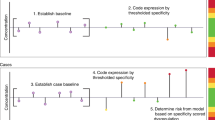Abstract
Mutation and overexpression of p53 occurs in 20-40% of breast cancers and has been shown to be an independent prognostic indicator. Recently we have demonstrated prostate-specific antigen (PSA) expression in breast tumours to be suggestive of favourable prognosis, but quantitative relationships between PSA and p53, and between these and other prognostic factors in breast cancer, have not been investigated. Time-resolved immunofluorometric procedures were used to quantify both p53 protein and PSA in 200 breast tumour extracts, which were also assayed for oestrogen (ER) and progesterone receptors (PGR), epidermal growth factor receptors (EGFR), cathepsin D and HER-2/neu, and characterised for S-phase fraction and DNA ploidy. Weak Spearman correlations were found between p53 and ER (r = - 0.18, P = 0.010), PGR (r = - 0.15, P = 0.0385) and S-phase fraction (r = 0.17, P = 0.016), while PSA was correlated only with PGR (r = 0.16, P = 0.025). Wilcoxon rank sum analysis revealed that levels of ER (P = 0.0001), PGR (P = 0.0001), S-phase fraction (P = 0.0001) and EGFR (P = 0.0014) differed significantly between the two groups categorised as p53 negative or p53 positive. Tumours classified as PSA negative or PSA positive were found to differ with respect to PGR (P = 0.0091) and S-phase fraction (P = 0.011) in a similar analysis. Contingency tables indicated significant negative associations between the status of p53 and that of ER (P = 0.003) and PGR (P = 0.001) and between PSA and S-phase fraction (P = 0.012), and positive associations between p53 and EGFR (P = 0.017), HER-2/neu (P = 0.008), S-phase fraction (P = 0.001) and aneuploidy (P = 0.007), and between PSA and both ER (P = 0.061) and PGR (P = 0.010). No significant associations were found between p53 and PSA. Our results demonstrate that the presence of p53 in breast tumours relates to several other variables which are suspected to predict aggressive tumour phenotypes and that the presence of PSA relates to variables associated with good prognosis.
This is a preview of subscription content, access via your institution
Access options
Subscribe to this journal
Receive 24 print issues and online access
$259.00 per year
only $10.79 per issue
Buy this article
- Purchase on Springer Link
- Instant access to full article PDF
Prices may be subject to local taxes which are calculated during checkout
Similar content being viewed by others
Author information
Authors and Affiliations
Rights and permissions
About this article
Cite this article
Levesque, M., Clark, G., Yu, H. et al. Immunofluorometric analysis of p53 protein and prostate-specific antigen in breast tumours and their association with other prognostic indicators. Br J Cancer 72, 720–727 (1995). https://doi.org/10.1038/bjc.1995.400
Issue Date:
DOI: https://doi.org/10.1038/bjc.1995.400
This article is cited by
-
Enhanced prediction of breast cancer prognosis by evaluating expression of p53 and prostate-specific antigen in combination
British Journal of Cancer (1999)
-
Expression of prostate-specific antigen (PSA) correlates with poor response to tamoxifen therapy in recurrent breast cancer
British Journal of Cancer (1999)



